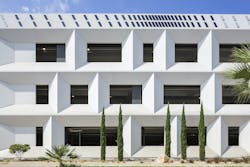San Diego Airport Transforms into Public Art
Inspired by World War I camouflage applied to naval ships, the monumental public artwork commissioned by San Diego County Regional Airport Authority features more than 2,000 solar-powered tiles that display custom, dynamic animations across the exterior of the building. The project features E Ink Prism, a digital ink technology similar to that found in e-readers adapted to an architectural scale.
For the DAZZLE project, the artist team at Ueberall International conceived a site-specific design that responds to the unique façade and brings the structure to life. Ueberall designed the artwork with inspiration from Norman Wilkinson’s “razzle dazzle” camouflage technique used during World War I in the waters of San Diego to alter the perception of naval ships to the enemy by visually scrambling their shapes and outlines.
The artist team experimented with different ways to execute a geometric camouflage pattern. The breakthrough came with the idea of applying e-paper technology to the 1,600-foot façade, turning it into a gigantic canvas for pixel animations. The e-paper tiles are articulated in a parallelogram shape and arranged in algorithmic distances to each other to create an overall dynamic visual effect, even when the pixels are still. Each tile has an integrated solar cell for power, electronics for operation, and wireless communication to create unique animations developed by the artists.
interiors+sources recently spoke with Nick Hafermaas, co-founder of Ueberall, to learn more about this groundbreaking art project and its innovative use of E Ink technology.
interiors+sources: Tell us more about the inspiration for the DAZZLE project and how you landed on the E Ink as a solution.
Nick Hafermaas: As a team of three artists, we applied for the request for qualification (RFQ) and once we got that job we went to work conceptually. We knew we wanted to do something that as a visual was a pretty radical digital transformation of that façade that’s a third of a mile long. As a reference, I came across dazzle camouflage, so the main conceptual idea is looking toward that historic ship camouflage which was done in World War I and was actually tested in the waters outside of the San Diego coast, so there’s a local connection.
Then we researched. The simplest thing is just to paint a black pattern onto the façade and call it a day. The next level up, then, was to explore different reflective materials, like the 3M film that you’d use for traffic signs or street markings. The idea was to have a passive pattern that still gets activated by the passing traffic.
We experimented. We went and did the full-scale mock ups and around that time I received a phone call from a gentleman from E-Ink and he said, ‘We like your work; we like your experimental approach. We are the makers of E-Ink material and we’ve done a couple of million Kindle screens. Now now we’re able to print out the same material a mile long, but we don’t know what to do with it.’ And this is where things fell into place. We said, ‘We just won an art commission to do a big façade; we should investigate whether your dynamic material is actually applicable to an outside installation.’
i+s: What were some of the challenges in applying the e-reader technology to such a large exterior?
NH: There were plenty of challenges that we had to overcome collectively and it only was possible because the engineers were willing to be very creative. Also, we had to find a common language and common understanding between art, design, and engineering and that worked extremely well with the E-Ink team.
i+s: What is your hope for this project?
NH: My hope would be—and also E-Ink’s hope—that our DAZZLE art piece is inspiring other architects, other corporations, to embrace a different approach to media and their environment. It’s not too much of a stretch to say that this will help revolutionize how we use media on an urban scale and architectural scale.
Photography Courtesy of Pablo Mason
About the Author
Robert Nieminen
Chief Content Director
Chief Content Director, Architectural Products, BUILDINGS, and interiors+sources
Robert Nieminen is the Chief Content Director of three leading B2B publications serving the commercial architecture and design industries: Architectural Products, BUILDINGS, and interiors+sources. With a career rooted in editorial excellence and a passion for storytelling, Robert oversees a diverse content portfolio that spans award-winning feature articles, strategic podcast programming, and digital media initiatives aimed at empowering design professionals, facility managers, and commercial building stakeholders.
He is the host of the I Hear Design podcast and curates the Smart Buildings Technology Report, bringing thought leadership to the forefront of innovation in built environments. Robert leads editorial and creative direction for multiple industry award programs—including the Elev8 Design Awards and Product Innovation Awards—and is a recognized voice in sustainability, smart technology integration, and forward-thinking design.
Known for his sharp editorial vision and data-informed strategies, Robert focuses on audience growth, engagement, and content monetization, leveraging AI tools and SEO-driven insights to future-proof B2B publishing.

